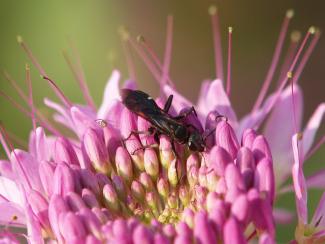
Image Credit: lostinfog
Spider-wasps (Pompilidae) – predators of predators – Relatives of the infamous “tarantula-hawks”, these wasps are widespread and abundant throughout the PNW; they are frequent flower-visitors, probably especially the males. The females hunt spiders, paralyze them with a sting, transport them to their burrow and feed them to their young. Though they obviously visit many types of flowers, I suspect that they are most important in the pollination of milkweeds (Asclepias). Milkweeds reproduce in a unique way – all their pollen grains from a single stamen are fused into 2 packet connected with a twisted “trap-wire”. Most milkweed flower-visitors either don’t contact the receptacle holding the device or have “ankles” that are too weak to remove the device. Spider-wasps have very strong ankles that permit them to remove the device and to “accidentally” replace it into another receptacle on a different plant. (However, it is a tricky process, and museum specimens (see below) of spider-wasps are characterized by lots of un-transferred milkweed pollen on their feet. It is dangerous for butterflies to visit milkweed flowers, since many amputated legs are generally embedded in the receptacles that unlucky butterflies have visited.)



Spider-wasps are actually hornets and have a prothorax similar to the yellow jackets (see illustration for hornets). Their prothorax is rather large to make room for the muscles of the front legs that must be used to dig thig the burrow. They often have black or red wings. The smaller species are often colored like true wasps. The central picture is of the foot of a spider-wasp in a museum drawer, complete with several milkweed pollinia that were never delivered to a recipient flower